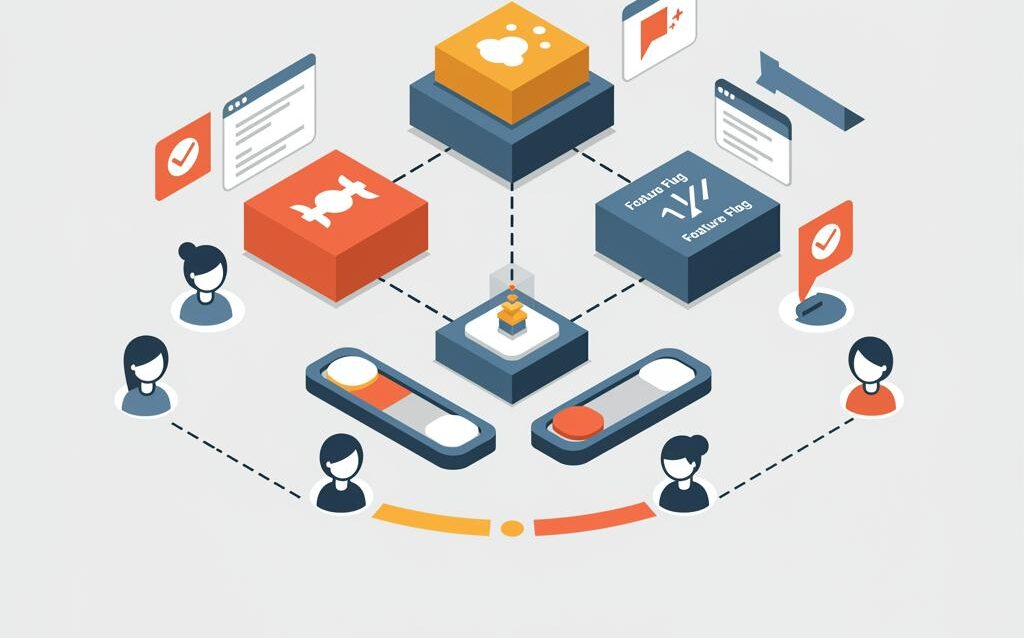Feature Flags: Progressive Deployment Strategies
Feature Flag Implementation: Progressive Deployment Strategies
Feature flags, also known as feature toggles, are a powerful technique for software development that allows you to enable or disable features without deploying new code. This enables a range of progressive deployment strategies, allowing you to release features to a limited audience, test in production, and roll back instantly if necessary. This blog post will explore various progressive deployment strategies you can implement using feature flags, along with practical considerations for each.
Understanding Progressive Deployment
Progressive deployment is an umbrella term for releasing features gradually, minimizing risk and maximizing learning. Instead of a traditional “big bang” release, features are rolled out in stages. Feature flags are the key enabler for this approach, providing the control to target specific user segments or environments. By using feature flags, you can decouple deployment from release, meaning you can deploy code without immediately exposing it to all users.
Benefits of Progressive Deployment
- Reduced Risk: Expose new features to a small subset of users first, identifying and resolving issues before they impact a wider audience.
- Faster Feedback: Gather real-world user feedback on new features early in the development lifecycle.
- A/B Testing: Compare different versions of a feature side-by-side to determine which performs better.
- Improved Stability: Monitor performance and stability in production before a full rollout, allowing for quick rollback if necessary.
- Controlled Rollouts: Gradually increase the user base exposed to a new feature, managing the impact on infrastructure and support.
Progressive Deployment Strategies with Feature Flags
Here are some common progressive deployment strategies that leverage feature flags:
Canary Releases
Canary releases involve deploying a new feature to a small subset of users or servers. These users are typically internal employees or a select group of beta testers. The goal is to monitor the feature’s performance and stability in a production environment before releasing it to a wider audience.
Implementation:
- Implement a feature flag that controls access to the new feature.
- Configure the feature flag to enable the feature only for a specific group of users (e.g., internal employees). This could be based on user ID, email address, or any other identifying attribute.
- Monitor the feature’s performance and stability closely.
- If any issues are detected, disable the feature flag to roll back the change.
- If the feature performs well, gradually increase the percentage of users who have access to it.
Dark Launching
Dark launching involves deploying a new feature to the production environment without exposing it to any users. This allows you to test the feature’s performance and stability under real-world load conditions without impacting the user experience.
Implementation:
- Implement a feature flag that controls access to the new feature.
- Configure the feature flag to disable the feature for all users.
- Run automated tests and monitor the feature’s performance and stability in the production environment.
- Once you are confident that the feature is working correctly, you can gradually enable it for a small group of users using a canary release strategy.
Ring-Based Rollouts
Ring-based rollouts involve deploying a new feature to a series of “rings,” each representing a progressively larger and more diverse group of users. This allows you to identify and address issues early in the rollout process, minimizing the impact on the user base.
Implementation:
- Ring 0 (Internal): The feature is initially deployed to internal employees.
- Ring 1 (Early Adopters/Beta Testers): A select group of external users who have opted in to beta testing.
- Ring 2 (Small Percentage of Users): A small percentage of the overall user base, selected randomly or based on specific criteria.
- Ring 3 (Increasing Percentage): Gradually increase the percentage of users in each ring.
- Ring 4 (Full Rollout): The feature is enabled for all users.
Each ring acts as a feedback loop, allowing you to gather insights and address issues before moving on to the next ring. Feature flags are crucial for controlling access to the feature in each ring.
A/B Testing
A/B testing allows you to compare different versions of a feature side-by-side to determine which performs better. This is often used to optimize user experience, improve conversion rates, or test different design variations.
Implementation:
- Implement two versions of the feature, each controlled by a separate feature flag.
- Use a feature flag management system to randomly assign users to one of the two versions.
- Track key metrics for each version, such as conversion rates, click-through rates, or user engagement.
- Analyze the data to determine which version performs better.
- Enable the winning version for all users and retire the other version.
Considerations for Implementing Feature Flags
While feature flags offer significant benefits, it’s important to consider the following:
Technical Debt
Over time, feature flags can accumulate and create technical debt if not managed properly. Establish a process for removing or cleaning up feature flags once they are no longer needed.
Complexity
Too many feature flags can make your code more complex and difficult to understand. Use feature flags judiciously and document their purpose and lifecycle.
Performance Impact
Feature flag logic can introduce a small performance overhead. Optimize your feature flag implementation to minimize this impact.
Testing
Thoroughly test your feature flag implementation to ensure that it is working correctly and that it does not introduce any unintended side effects.
Conclusion
Feature flags are an invaluable tool for enabling progressive deployment strategies. By carefully planning and implementing feature flags, you can significantly reduce the risk associated with software releases, gather faster feedback, and improve the overall quality of your software. By choosing the right strategy and considering the practical considerations, you can successfully leverage feature flags to achieve a more agile and reliable development process.

